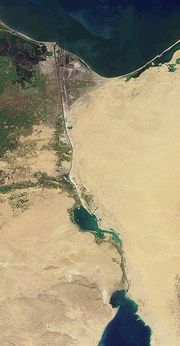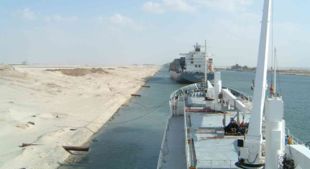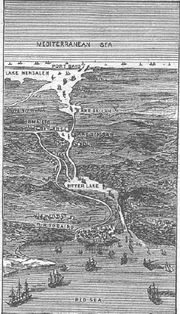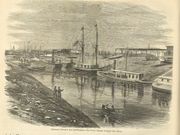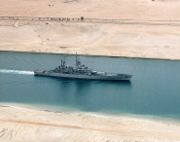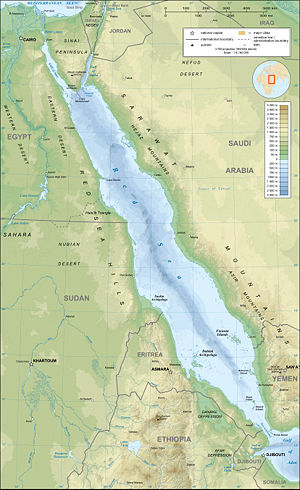Suez Canal
2008/9 Schools Wikipedia Selection. Related subjects: African Geography; Air & Sea transport
The Suez Canal ( transliteration: Qanāt al-Suways), is a large man-made canal in Egypt, west of the Sinai Peninsula. It is 163 km (101 miles) long and 300 m (984 ft) wide at its narrowest point, and runs between Port Said (Būr Sa'īd) on the Mediterranean Sea, and Suez (al-Suways) on the Red Sea.
The canal allows two-way water transportation between Europe and Asia without circumnavigation of Africa. Before its opening in 1869, goods were sometimes offloaded from ships and carried overland between the Mediterranean and the Red Sea.
The canal comprises seven parts, north and south of the Great Bitter Lake, linking the Mediterranean Sea to the Gulf of Suez on the Red Sea.
History
2nd millennium BC
Perhaps as early as the 12th Dynasty, Pharaoh Senusret III ( 1878 BC– 1839 BC) may have had a west-east river dug through the Wadi Tumilat, joining the River Nile with the Red Sea (which in ancient times reached north to the Bitter Lakes. This allowed direct trade with Punt, and, indirectly, linked the Red Sea and the Mediterranean.
The reliefs of the Punt expedition under Hatshepsut depict sea-going vessels carrying the expeditionary force returning from Punt. This has given rise to the theory that, at the time, a navigable link existed between the Red Sea and the Nile.
Evidence indicates its existence by the 13th century BC during the time of Ramesses II.
Repair by Necho, Darius I, and Ptolemy
The waterway fell into disrepair, and according to the Histories of the Greek historian Herodotus, about 600 BC, Necho II undertook re-excavation but did not complete it. Herodotus was told that 120,000 men perished in this undertaking. With Necho's death, work was discontinued.
The canal was finally completed by Darius I of Persia, who conquered Egypt. According to Herodotus, the completed canal was wide enough that two triremes could pass each other with oars extended, and required four days to traverse. Darius commemorated his achievement with a number of granite stelae that he set up on the Nile bank, including one near Kabret, 130 miles (209 km) from Pie. The Darius Inscriptions read:
| “ | Saith King Darius: I am a Persian. Setting out from Persia, I conquered Egypt. I ordered this canal dug from the river called the Nile that flows in Egypt, to the sea that begins in Persia. When the canal had been dug as I ordered, ships went from Egypt through this canal to Persia, even as I intended. | ” |
The canal left the Nile at Bubastis. An inscription on a pillar at the canal's Red Sea end at Pithom records that in 270/69 it was again reopened, by Ptolemy II Philadelphus. Over the next 1000 years it was successively modified, destroyed and rebuilt, until finally it was put out of commission in the eighth century by the Abbasid Caliph al-Mansur.
Napoleon considers repair
At the end of the 18th century while in Egypt, Napoleon Bonaparte contemplated the construction of a canal to join the Mediterranean and Red Seas. But his project was abandoned after the preliminary survey erroneously concluded that the Red Sea was 10 metres higher than the Mediterranean, making a locks-based canal too expensive and very long to construct. The Napoleonic survey commission's error came from fragmented readings mostly done during wartime, which resulted in imprecise calculations.
Re-construction by Suez Canal Company
In 1854 and 1856 Ferdinand de Lesseps obtained a concession from Said Pasha, the viceroy of Egypt, to create a company to construct a canal open to ships of all nations, according to plans created by Austrian engineer Alois Negrelli. The company was to operate the canal by leasing the relevant land, for 99 years from its opening. De Lesseps had used his friendly relationship with Said, which he had developed while he was a French diplomat during the 1830s. The Suez Canal Company ( Compagnie Universelle du Canal Maritime de Suez) came into being on 15 December 1858.
The excavation took nearly 11 years using forced labour of Egyptian workers. Some sources estimate that over 30,000 people were forced to work on the canal.
The British recognised the canal as an important trade route and perceived the French project as a threat to their geopolitical and financial interests. The British Empire was the major global naval force and its power had increased during the American Civil War years 1861-65. The British government officially condemned the forced work and sent armed bedouins to start a revolt among workers. Involuntary labour on the project ceased, and the viceroy condemned the slavery, halting the project.
Angered by the British opportunism, de Lesseps sent a letter to the British government remarking on the British lack of remorse a few years earlier when forced workers died in similar conditions building the British railroad in Egypt.
Initially international opinion was skeptical and Suez Canal Company shares did not sell well overseas. Britain, the United States, Austria and Russia did not buy any shares. All French shares were quickly sold in France. A contemporary British skeptic claimed:
| “ | "One thing is sure... our local merchant community doesn't pay practical attention at all to this grand work, and it is legitimate to doubt that the canal's receipts... could ever be sufficient to recover its maintenance fee. It will never become a large ships accessible way in any case." (reported by German historian Uwe A. Oster) | ” |
The canal opened to shipping on 17 November 1869. Although numerous technical, political, and financial problems had been overcome, the final cost was more than double the original estimate.
The canal had an immediate and dramatic effect on world trade. Combined with the American transcontinental railroad completed six months earlier, it allowed the entire world to be circled in record time. It played an important role in increasing European penetration and colonization of Africa. External debts forced Said Pasha's successor, Isma'il Pasha, to sell his country's share in the canal for £4,000,000 to the United Kingdom in 1875, but France still remained the majority shareholder. Prime minister Benjamin Disraeli was accused by William Gladstone of undermining Britain's constitutional system , due to his lack of reference or consent from Parliament when purchasing the shares with funding from the Rothschilds. .
The Convention of Constantinople in 1888 declared the canal a neutral zone under the protection of the British; British troops had moved in to protect it during a civil war in Egypt in 1882. Under the Anglo-Egyptian Treaty of 1936, the UK insisted on retaining control over the canal. In 1951 Egypt repudiated the treaty, and in 1954 the UK agreed to remove its troops, and withdrawal was completed in July 1956.
Suez Crisis
After the United Kingdom and the United States withdrew their pledge to support the construction of the Aswan Dam due to Egyptian overtures towards the Soviet Union, Egyptian President Gamal Abdel Nasser nationalised the canal in 1956, intending to finance the dam project using revenue from the canal, while at the same time closing the Gulf of Aqaba to all Israeli shipping by closure of the Straits of Tiran. This provoked the Suez Crisis, in which the UK, France and Israel colluded to invade Egypt. The intention was for Israel to invade on the ground, and for the Anglo-French partnership to give air and other support, later to intervene to resolve the crisis and control the canal.
To stop the war from spreading and to save the British from what he thought was a disastrous action, Canadian Secretary of State for External Affairs, Lester B. Pearson, proposed the creation of the very first United Nations peacekeeping force to ensure access to the canal for all and an Israeli withdrawal from the Sinai. On 4 November 1956, a majority of nations at the United Nations voted for Pearson's peacekeeping resolution, which mandated the UN peacekeepers to stay in the Sinai Peninsula unless both Egypt and Israel agreed to their withdrawal. The US backed this proposal by putting financial pressure on the British government, which then agreed to withdraw its troops. Pearson was later awarded the Nobel Peace Prize.
As a result of damage and ships intentionally sunk under orders from Nasser the canal was closed until April 1957, when it was cleared with UN assistance. A UN force ( UNEF) was established to maintain the neutrality of the canal and the Sinai Peninsula.
The Arab-Israeli wars of 1967 and 1973
In May 1967 President Nasser ordered the UN peacekeeping forces out of the Sinai Peninsula, including the Suez Canal area. Despite Israeli objections in the United Nations, the peacekeepers were withdrawn and the Egyptian army took up positions on the Israeli border, closing the Straits of Tiran to Israeli shipping. The canal itself had been closed to Israeli shipping since 1949, except for a short period in 1951-1952.
These actions were key factors in the Israeli decision to launch a pre-emptive attack on Egypt in June 1967, and to capture the Sinai Peninsula to the Suez Canal. After the 1967 Arab-Israeli war, also called the Six Day War, the canal was closed by an Egyptian blockade until 5 June 1975. As a result, fourteen cargo ships known as " The Yellow Fleet" remained trapped in the canal for over eight years. In 1973, during the Yom Kippur War, the canal was the scene of a major crossing by the Egyptian army into Israeli-occupied Sinai, followed by an Israeli counteroffensive which ended in a cease-fire. Much wreckage from this conflict remains visible along the canal's edges.
The UNEF mandate expired in 1979. Despite the efforts of the US, Israel, Egypt, and others to obtain an extension of the UN role in observing the peace between Israel and Egypt, as called for under the Egypt-Israel Peace Treaty of 1979, the mandate could not be extended because of the veto by the USSR in the security council, at the request of Syria. Accordingly, negotiations for a new observer force in the Sinai produced the Multinational Force and Observers (MFO), stationed in Sinai in 1981 in coordination with a phased Israeli withdrawal. It is there under agreements between the US, Israel, Egypt, and other nations. ( Multinational Force and Observers).
Shooting involving Global Patriot
On 25 March 2008 US Navy security teams, aboard a civilian cargo ship, Global Patriot, which was under short term charter from the US Navy, shot at a small Egyptian boat causing one fatality.
Operation
The canal has no locks due to the flat terrain, and the minor sea level difference between each end is inconsequential.
The canal allows passage of ships up to 150,000 tons displacement. It permits ships up to 16 m (53 ft) draft to pass, and improvements are planned to increase this to 22 m (72 ft) by 2010, allowing passage of fully-laden supertankers. Presently, supertankers can offload part of their cargo onto a canal-owned boat and reload at the other end of the canal. Tankers exceeding Suezmax, the largest permissible size through the canal, must travel around the Cape of Good Hope.
There is one shipping lane with several passing areas. On a typical day, three convoys transit the canal, two southbound and one northbound. The first southbound convoy enters the canal in the early morning hours and proceeds to the Great Bitter Lake, where the ships anchor out of the fairway, awaiting passage of the northbound convoy. The northbound convoy passes the second southbound convoy, which moors in a bypass near El Qantara. The passage takes between 11 and 16 hours at a speed of around 8 knots (15 km/h). The low speed helps prevent erosion of the canal banks by ships' wakes.
Egypt's Suez Canal Authority (SCA) reported that in 2003 17,224 ships passed through the canal. The canal averages about 8% of the world shipping traffic.
By 1955 approximately two-thirds of Europe's oil passed through the canal. About 7.5% of world sea trade is carried via the canal today. Receipts from the canal July 2005 to May 2006 totaled $3.246 billion. In 2007, 18,193 vessels passed through the canal.
On 30 December 2007 it was announced that Egypt will increase Suez Canal transit fees by an average of 7.1% in 2008.
Connections between the shores
From north to south connections are:
- The Suez Canal Bridge, also called the Egyptian-Japanese Friendship Bridge, is a high-level road bridge at El Qantara. In Arabic, al qantara means "the bridge". It has a 70-metre clearance over the canal and was built with assistance from the Japanese government and by PentaOcean Construction.
- El Ferdan Railway Bridge 20 km north of Ismailia was completed in 2001 and is the longest swing span bridge in the world, with a span of 340 m (1100 ft). The previous bridge was destroyed in 1967 during the Arab-Israeli conflict.
- Pipelines taking fresh water under the canal to Sinai, about 57km north of Suez, at .
- Ahmed Hamdi Tunnel south of the Great Bitter Lake was built in 1983. Because of leakage problems, a new water-tight tunnel was built inside the old one, from 1992 to 1995.
- The Suez Canal overhead line crossing powerline was built in 1999.
A railway on the west bank runs parallel to the canal for its entire length.
Environmental impact
The opening of the Suez Canal in 1869 created the first salt-water passage between the Mediterranean and Red seas. The Red Sea is about 1.2 m higher than the eastern Mediterranean , so the canal serves as a tidal strait that pours Red Sea water into the Mediterranean. The Bitter Lakes, which are hypersaline natural lakes that form part of the canal, blocked the migration of Red Sea species into the Mediterranean for many decades, but as the salinity of the lakes gradually equalised with that of the Red Sea, the barrier to migration was removed, and plants and animals from the Red Sea have begun to colonise the eastern Mediterranean. The Red Sea is generally saltier and more nutrient-poor than the Atlantic, the direction of flow is generally from the Red Sea to the Mediterranean, so the Red Sea species have advantages over Atlantic species in the salty and nutrient-poor eastern Mediterranean. Accordingly, most Red Sea species invade the Mediterranean biota, and only few do the opposite. This migratory phenomenon is called Lessepsian migration (after Ferdinand de Lesseps) or Erythrean invasion. The construction of the Aswan High Dam across the River Nile in the 1960s reduced the inflow of freshwater and nutrient-rich silt from the Nile into the eastern Mediterranean, making conditions there even more like the Red Sea, worsening the impact of the invasive species.
Invasive species originated from the Red Sea and introduced into the Mediterranean by the construction of the canal have become a major component of the Mediterranean ecosystem, and have serious impacts on the Mediterranean ecology, endangering many local and endemic Mediterranean species. Currently about 300 species from the Red Sea have been identified in the Mediterranean Sea, and there are probably others yet unidentified. The Egyptian government's intent to enlarge the canal have raised concerns from marine biologists, fearing that this will worsen the invasion of Red Sea species in the Mediterranean. .
Construction of the Suez Canal was preceded by cutting a small fresh-water canal from the Nile delta along Wadi Tumilat to the future canal, with a southern branch to Suez and a northern branch to Port Said. Completed in 1863, these brought fresh water to a previously arid area, initially for canal construction, and subsequently facilitating growth of agriculture and settlements along the canal.
Timeline
- Circa 1799 — Napoleon I of France conquered Egypt and ordered a feasibility analysis. This reported a supposed 10 metre difference in sea levels and a high cost, so the project was set on standby.
- Circa 1840 — A second survey found the first one incorrect. A direct link between the Mediterranean Sea and the Red Sea would be possible and not be as expensive as expected.
- Circa 1854 — The French consul in Cairo, Ferdinand Marie de Lesseps, created the "Compagnie Universelle du Canal Maritime de Suez".
- 25 Apr 1859 — The French were allowed to begin canal construction (Said Pacha acquired 22% of the Suez Canal Company, the remainder controlled by French private holders).
- 16 Nov 1869 — The Suez Canal opened; operated and owned by Suez Canal Company.
- 25 Nov 1875 — Britain became a minority share holder in the Suez Company, acquiring 44% of the Suez Canal Company. The remainder were controlled by French syndicates.
- 25 Aug 1882 — Britain took control of the canal.
- 2 Mar 1888 — The Convention of Constantinople guaranteed right of passage of all ships through the Suez Canal during war and peace.
- 14 Nov 1936 — Suez Canal Zone established, under British control.
- 13 Jun 1956 — Suez Canal Zone restored to Egypt.
- 26 Jul 1956 — Egypt nationalised the Suez Canal.
- 5 Nov 1956 to 22 Dec 1956 — French, British, and Israeli forces occupied the Suez Canal Zone.
- 22 Dec 1956 — Restored to Egypt.
- 5 June 1967 to 10 June 1967 — Canal closed and blockaded by Egypt, against Israel, sparking the Six-Day War.
- 5 June 1975 — Suez Canal reopened.
Presidents of the Suez Canal Company (1855-1956)
Before nationalisation:
- Ferdinand De Lesseps, (1855 – 7 December 1894)
- Jules Guichard ( 17 December 1892 – 17 July 1896) (acting for de Lesseps to 7 December 1894)
- Auguste-Louis-Albéric, prince d'Arenberg ( 3 August 1896 – 1913)
- Charles Jonnart ( 19 May 1913 – 1927)
- Louis de Vogüé ( 4 April 1927 – 1 March 1948)
- François Charles-Roux ( 4 April 1948 – 26 July 1956)
Chairmen of the Suez Canal Authority (1956-Present)
Since nationalisation:
- Doctor Mohamed Helmy Bahgat Badawy ( 26 July 1956 – 9 July 1957)
- Engineer Mahmoud Younis ( 10 July 1957 – 10 October 1965)
- Engineer Mashhour Ahmed Mashhour ( 14 October 1965 – 31 December 1983)
- Engineer Mohamed Ezzat Adel ( 1 January 1984 – December 1995)
- Admiral Ahmed Ali Fadel ( 22 January 1996 – Present)
British Vice-Consuls of Port Suez (1922-1941)
- G. E. A. C. Monck-Mason, 1922 – 1924
- G. C. Pierides (acting), 1924 – 1925
- Thomas Cecil Rapp, 1925 – 1926
- Abbas Barry (acting), 1926 – 1927
- E. H. L. Hadwen (acting to 1930), 1927 – 1931
- A. N. Williamson-Napier, 1931 – 1934
- H. M. Eyres, 1934 – 1936
- D. J. M. Irving, 1936 – 1940
- R. G. Dundas, 1940 – 1941
British Consuls of Port Suez (1941-1956)
- R. G. Dundas, 1941 – 1942
- H. G. Jakins, 1942 – 1944
- W. B. C. W. Forester, 1944 – 1946
- Frederick Herbert Gamble, 1946 – 1947
- E. M. M. Brett (acting), 1947 – 1948
- C. H. Page, 1948 – 1954
- F. J. Pelly, 1954 – 1955
- J. A. D. Stewart-Robinson (acting), 1955 – 1956
- J. Y. Mulvenny, 1956
Governors of the Suez Canal Zone
- 14 Nov 1936 – 24 Jul 1939: ?
- 24 Jul 1939 – 7 May 1941: Sir Archibald Wavell
- 7 May 1941 – 7 Aug 1942: Sir Claude John Eyre Auchinleck
- 7 Aug 1942 – 19 Feb 1943: Harold Rupert Leofric George Alexander
- 19 Feb 1943 – 6 Jan 1944: Henry Maitland Wilson
- 6 Jan 1944 – Jun 1946: Sir Bernard Charles Tolver Paget
- Jun 1946 – Jun 1947: Miles Christopher Dempsey
- Jun 1947 – 25 Jul 1950: Sir John Tredinnick Crocker
- 25 Jul 1950 – Apr 1953: Sir Brian Hubert Robertson
- Apr 1953 – 28 Sep 1953: Sir Cameron Gordon Graham Nicholson
- 28 Sep 1953 – 13 Jun 1956: Sir Charles Frederic Keightley
Supreme Allied Commander
During the Suez Crisis:
Popular culture
Suez, a film made in 1938, starred Tyrone Power as de Lesseps and Loretta Young as a love interest. An epic, it is very loosely based on history.
The Suez Canal appears in the 1962 film Lawrence of Arabia, where it marks the end of T. E. Lawrence's march across the Sinai Peninsula to report to his superiors in Cairo.
The Suez Canal is also a playable map in the game Battlefield 2142.
